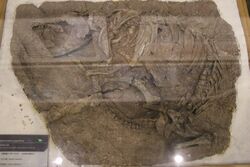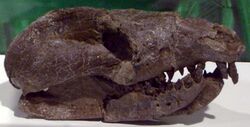Biology:Repenomamus
| Repenomamus | |
|---|---|

| |
| Type of R. giganticus, Paleozoological Museum of China | |
| Scientific classification | |
| Missing taxonomy template (fix): | Eutriconodonta/? |
| Family: | †Gobiconodontidae |
| Genus: | †Repenomamus Li et al., 2000 |
| Type species | |
| †Repenomamus robustus Li et al., 2001[1]
| |
| Species | |
|
†Repenomamus robustus Li et al., 2000 | |
Repenomamus (Latin: "reptile" (reptilis), "mammal" (mammalis)[2]) is a genus of opossum- to badger-sized gobiconodontid[3] mammal containing two species, Repenomamus robustus and Repenomamus giganticus. Both species are known from fossils found in China that date to the early Cretaceous period, about 125-123.2 million years ago. R. robustus is one of several Mesozoic mammals[7] for which there is good evidence that it fed on vertebrates, including dinosaurs. Though it is not entirely clear whether or not these animals primarily hunted live dinosaurs or scavenged dead ones, evidence for the former is present in fossilized remains showcasing the results of what was most likely a predation attempt by R. robustus directed at a specimen of the dinosaur Psittacosaurus lujiatunensis.[8] R. giganticus is among the largest mammals known from the Mesozoic era.
Classification and discovery
The fossils were recovered from the lagerstätte of the Yixian Formation in the Liaoning province of China, which is renowned for its extraordinarily well-preserved fossils of feathered dinosaurs. They have been specifically dated to 125–123.2 million years ago, during the Early Cretaceous period.
Repenomamus is a genus of triconodonts, a group of early mammals with no modern relatives. R. robustus was described by Li, Wang, Wang and Li in 2000, and R. giganticus was described by Hu, Meng, Wang and Li in 2005. The two known species are the sole members of the family Repenomamidae, which was also described in the same paper in 2000. It is sometimes alternatively listed as a member of the family Gobiconodontidae; although this assignment is controversial, a close relationship to this family is well-founded.
Description
Individuals of the known species in Repenomamus are the largest known Mesozoic mammals[9][6][10][11][12][13] represented by reasonably complete fossils[10][11] (though Kollikodon may be larger,[14] and Schowalteria, Oxlestes, Khuduklestes and Bubodens reached similar if not larger sizes[15][16]). Adults of R. robustus were the size of a Virginia opossum. It had body length without tail of 41.2 cm (16 in) for complete specimen with estimated skull length of 10.6 cm (4.2 in), although there is more partial specimen that had 11.2 cm (4.4 in) skull. Estimated mass of R. robustus is 4–6 kg (8.8–13 lb). The known adult of R. giganticus was about 50% larger than R. robustus, with a body length of 68.2 cm (27 in) and total length over 1 m (3 ft 3 in) (skull reaching 16 cm (6.3 in), trunk of 52.2 cm (21 in) and preserved tail 36.4 cm (14 in) in length) and an estimated mass of 12–14 kg (26–31 lb).[17] These finds extend considerably the known body size range of Mesozoic mammals. In fact, Repenomamus was larger than several small sympatric dromaeosaurid dinosaurs like Graciliraptor.[17][10] Features of its shoulder and legs bones indicate a sprawling posture as in most of small to medium sized living therian mammals, with plantigrade feet. Unlike therian mammals, Repenomamus had a proportionally longer body with shorter limbs.
The dental formula was originally interpreted as 3.1.2.42.1.2.5, though a more recent study indicates instead that it was 3.1.1.52.1.2.5.[18]
Paleobiology
Features of the teeth and jaw suggest that Repenomamus were carnivorous and a specimen of R. robustus discovered with the fragmentary skeleton of a juvenile Psittacosaurus preserved in its stomach represents the second direct evidence that at least some Mesozoic mammals were carnivorous and fed on other vertebrates, including dinosaurs;[17] a recorded attack on an Archaeornithoides by a Deltatheridium predates its description.[19] More evidence suggesting Repenomamus was suited to a predatory lifestyle was later revealed when a specimen of R. robustus was uncovered alongside an adult Psittacosaurus. The intertwined nature of the fossil, similar to the Fighting Dinosaurs fossil of Mongolia, was likely a byproduct of an altercation between the two animals in which the mammal was most likely the instigator of an ongoing predation attempt. This was posited on the basis that the Repenomamus involved was noted to have been latching on to the Psittacosaurus with its arms and legs while biting the dinosaur.[8] Speciations towards carnivory are known in eutriconodonts as a whole, and similarly large sized species like Gobiconodon, Jugulator and even Triconodon itself[20] are thought to have tackled proportionally large prey as well; evidence of scavenging is even assigned to the former.[6]
Like most other non-placental mammals, Repenomamus had epipubic bones, implying that it gave birth to undeveloped young like modern marsupials, or laid eggs like modern monotremes.[17]
See also
References
- ↑ Li (2001). "A new family of primitive mammal from the Mesozoic of western Liaoning, China". Chinese Science Bulletin 46 (9): 782–785. doi:10.1007/bf03187223. Bibcode: 2001ChSBu..46..782L.
- ↑ "Glossary. American Museum of Natural History". https://research.amnh.org/paleontology/perissodactyl/concepts/glossary.
- ↑ Marisol Montellano; James A. Hopson; James M. Clark (2008). "Late Early Jurassic Mammaliaforms from Huizachal Canyon, Tamaulipas, México". Journal of Vertebrate Paleontology 28 (4): 1130–1143. doi:10.1671/0272-4634-28.4.1130. Bibcode: 2008JVPal..28.1130M.
- ↑ "New Specimen Reveals Delta Theroidan Affinities of the North American Late Cretaceous Mammal Nanocuris". Journal of Vertebrate Paleontology 30 (3): 872–884. 2010. doi:10.1080/02724631003762948. Bibcode: 2010JVPal..30..872W.
- ↑ Christian DE MUIZON, Brigitte LANGE-BADRÉ (2007). "Carnivorous dental adaptations in tribosphenic mammals and phylogenetic reconstruction". Lethaia 30 (4): 353–366. doi:10.1111/j.1502-3931.1997.tb00481.x.
- ↑ 6.0 6.1 6.2 Zofia Kielan-Jaworowska, Richard L. Cifelli, Zhe-Xi Luo (2004). "Chapter 12: Metatherians". Mammals from the Age of Dinosaurs: origins, evolution, and structure. New York: Columbia University Press. pp. 241–243. ISBN 978-0-231-11918-4. https://books.google.com/books?id=qJGcX3X0EaMC.
- ↑ Other eutriconodonts and deltatheroidean metatherians have adaptations towards specialised carnivory[4][5][6]
- ↑ 8.0 8.1 Han, Gang; Mallon, Jordan C.; Lussier, Aaron J.; Wu, Xiao-Chun; Mitchell, Robert; Li, Ling-Ji (2023-07-18). "An extraordinary fossil captures the struggle for existence during the Mesozoic" (in en). Scientific Reports 13 (1): 11221. doi:10.1038/s41598-023-37545-8. ISSN 2045-2322. PMID 37464026.
- ↑ Paul Selden, John Nudds (Sep 19, 2012). Evolution of Fossil Ecosystems. Secont edition. Academic Press. p. 178. ISBN 978-0-12-404629-0. https://books.google.com/books?id=DUli1Mb8j7QC. Retrieved 2022-08-25.
- ↑ 10.0 10.1 10.2 Donald R. Prothero (November 15, 2016). The Princeton Field Guide to Prehistoric Mammals. Princeton University Press. p. 33. ISBN 978-0-691-15682-8. https://books.google.com/books?id=tWiYDwAAQBAJ&dq=repenomamus+largest&pg=PA33. Retrieved 2022-08-25.
- ↑ 11.0 11.1 Frank Zachos, Robert Asher (October 22, 2018). Mammalian Evolution, Diversity and Systematics. De Gruyter. p. 224. ISBN 978-3-11-034155-3. https://books.google.com/books?id=dQd2DwAAQBAJ&dq=repenomamus+largest&pg=PA224. Retrieved 2022-08-25.
- ↑ Kenneth D. Rose (2006). The Beginning of the Age of Mammals. Johns Hopkins University Press. p. 62. ISBN 978-0-8018-8472-6. https://books.google.com/books?id=3bs0D5ix4VAC&dq=repenomamus+largest&pg=PA62. Retrieved 2022-08-25.
- ↑ Zofia Kielan-Jaworowska (2013). In Pursuit of Early Mammals. Indiana University Press. p. 115. ISBN 978-0-253-00824-4. https://books.google.com/books?id=wuwtxuJoX6IC&dq=repenomamus+largest&pg=PA715. Retrieved 2022-08-25.
- ↑ Clemens et al., 2003
- ↑ Fox R. C., Naylor B. G. (2003). "A Late Cretaceous taeniodont (Eutheria, Mammalia) from Alberta, Canada". Neues Jahrbuch für Geologie und Paläontologie 229 (3): 393–420. doi:10.1127/njgpa/229/2003/393.
- ↑ Wilson R. W. (1987). "Late Cretaceous (Fox Hills) multituberculates from the Red Owl local fauna of western South Dakota". Dakoterra 3: 118–122.
- ↑ 17.0 17.1 17.2 17.3 Hu (2005). "Large Mesozoic mammals fed on young dinosaurs". Nature 433 (7022): 149–152. doi:10.1038/nature03102. PMID 15650737. Bibcode: 2005Natur.433..149H. http://doc.rero.ch/record/15291/files/PAL_E2590.pdf.
- ↑ Alexey Lopatin, Alexander Averianov, Gobiconodon (Mammalia) from the Early Cretaceous of Mongolia and Revision of Gobiconodontidae, First online: 12 July 2014
- ↑ Elzanowski, A.; Wellnhofer, P. (1993). "Skull of Archaeornithoides from the Upper Cretaceous of Mongolia". American Journal of Science 293: 235–252. doi:10.2475/ajs.293.A.235. Bibcode: 1993AmJS..293..235E. http://earth.geology.yale.edu/~ajs/1993/11.1993.08Elzanowski.pdf.
- ↑ "Triconodon | fossil mammal genus". https://www.britannica.com/animal/Triconodon.
External links
- "Prehistoric badger had dinosaurs for breakfast". Michael Hopkin. Nature.com. January 12, 2005.
- "Fierce mammal ate dinos for lunch". BBC News. January 12, 2005.
Wikidata ☰ Q131960 entry
 |




